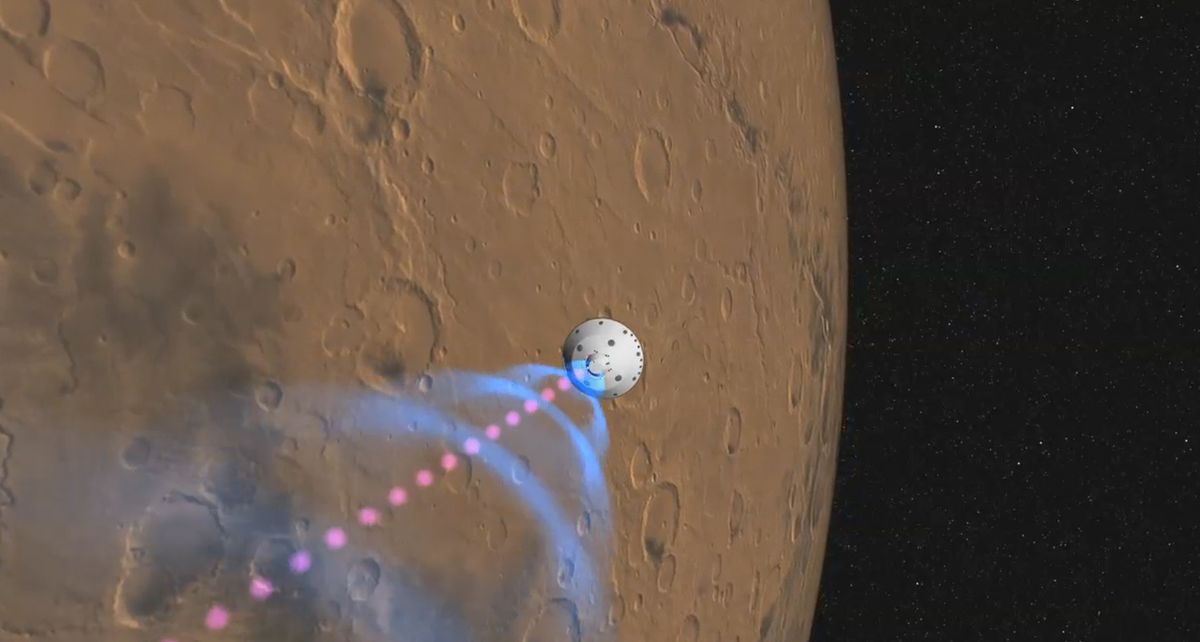NASA counting down
Curiosity’s landing first of its kind

PASADENA, Calif. – The most high-tech rover NASA has ever designed was speeding toward Mars Sunday to attempt an acrobatic landing on the planet’s surface.
The Curiosity rover was poised to hit the top of the Martian atmosphere at 13,000 mph. If all goes according to script, it will be slowly lowered into a massive crater by cables in the final few seconds.
With Curiosity on autopilot, engineers became spectators, anxiously waiting to see if Curiosity executes the routine as planned.
“I’m not the nervous type, but I haven’t been sleeping all that well the last week or so even though I’m still very confident,” said engineer Steven Lee.
NASA was ready for the “Super Bowl of planetary exploration,” said Doug McCuistion, head of the Mars exploration program at NASA headquarters.
“We score and win or we don’t score and we don’t win,” said McCuistion.
Like football’s Super Bowl, there were celebrities on hand. More than a dozen were invited to watch the landing at NASA’s Jet Propulsion Laboratory, including will.i.am, Wil Wheaton, Seth Green, Morgan Freeman and Alex Trebek.
If all goes well, mission control at the JPL should hear a signal at 10:31 p.m. PDT. The space agency warned that confirmation could take longer if an orbiting spacecraft that’s supposed to listen for Curiosity during the descent is not in the right place.
Curiosity’s trajectory was so accurate that engineers decided to wave off a last chance to tweak its position before atmosphere entry.
“We’re ready to head in,” said mission manager Brian Portock.
Not ones to tempt fate, flight controllers planned to break out the “good luck” peanuts before Curiosity takes the plunge as part of a long-running tradition.
“It’s definitely the quiet before the storm,” said NASA sciences chief John Grunsfeld. “There’s tremendous anticipation.”
Steve Squyres, who headed NASA’s last successful rover mission in 2004, can relate to the building anxiety.
“Landing on Mars is always a nerve-racking thing. You’re never going to get relaxed about something like landing a spacecraft on Mars,” said Squyres.
Sunday’s touchdown attempt was especially intense because NASA is testing a brand new landing technique. Due to the communication delay between Mars and Earth, Curiosity will be on autopilot. The voyage to Mars took over eight months and spanned 352 million miles. The trickiest part of the journey? The landing. Because Curiosity weighs nearly a ton, engineers drummed up a new and more controlled way to set the rover down.
The plans called for a series of braking tricks, similar to those used by the space shuttle, and a supersonic parachute to slow it down. Next: Ditch the heat shield used for the fiery descent.
And in a new twist, engineers came up with a way to lower the rover by cable from a hovering rocket-powered backpack. At touchdown, the cords cut and the rocket stage crashes a distance away.
The nuclear-powered Curiosity, the size of a small car, is packed with scientific tools, cameras and a weather station. It sports a robotic arm with a power drill, a laser that can zap distant rocks, a chemistry lab to sniff for the chemical building blocks of life and a detector to measure dangerous radiation on the surface.
After several weeks of health checkups, the six-wheeled rover could take its first short drive and flex its robotic arm.
The landing site near Mars’ equator was picked because there are signs of water everywhere, meeting one of the requirements for life as we know it. Inside Gale Crater is a 3-mile-high mountain, and images from space show the base appears rich in minerals that formed in the presence of water.
Previous trips to Mars have uncovered ice near the Martian north pole and evidence that water once flowed when the planet was wetter and toastier unlike today’s harsh, frigid desert environment.
Curiosity’s goal: To scour for basic ingredients essential for life, including carbon, nitrogen, phosphorous, sulfur and oxygen. It’s not equipped to search for living or fossil microorganisms. To get a definitive answer, a future mission needs to fly Martian rocks and soil back to Earth to be examined.